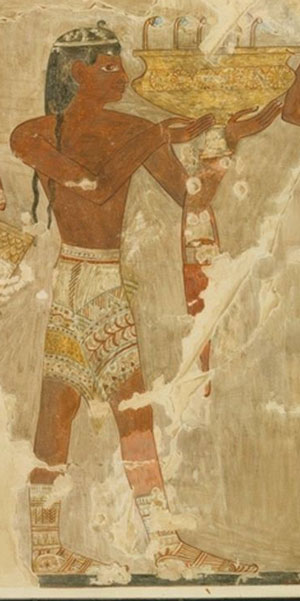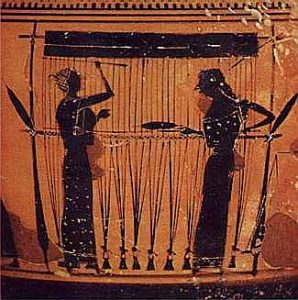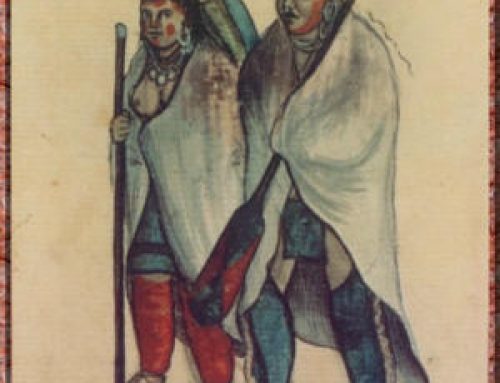When was weaving invented?

History of weaving: Warp on a loom
Weaving was probably invented much later than spinning, around 6000 BC, in West Asia.
History of spinning
West Asian clothing
All our West Asia articles
First came band-weaving.
At first people just wove narrow bands with their fingers, tying one end to their belt. That was something like the finger-knitting you might know how to do. That kind of weaving remained common for a long time in Central Asia, where people were nomadic and couldn’t carry big heavy looms with them.
Central Asian clothing

Minoan man wearing a kilt that may be made of band-woven strips sewn together, from the tomb of Rekhmire, in Egypt, about 1400 BC.
You could do band-weaving while you were riding a horse, so it was better for nomads than loom-weaving. People sewed the long bands – like ribbons or headbands – together along the long sides. They wrapped those cloths around their middles to make skirts or kilts.
In this picture from New Kingdom Egypt, a Minoan man wears a kilt that seems to be made this way, by sewing five or six bands together.
(More about this band-weaving thing from Elizabeth Barber)
The first big looms
But by about 6000 BC, enough people had settled down to live in houses with courtyards that some of them started to use big heavy looms. A loom is a wooden frame that keeps the strings pulled tight so you can weave in and out of them conveniently.
What was going on in 6000 BC?
In sunny places like Egypt or Iran, people stretch out the loom horizontally in the courtyard. In the video, a woman uses a horizontal loom. You can also see a horizontal loom in the model of a weaving workshop from an Egyptian tomb (scroll down).
But in rainy or cold places, like Greece and Italy, people used a loom that stood up against the wall, so you could use it inside the house.
Weaving in the Americas
People also invented weaving in the Americas, maybe around the same time as in Afro-Eurasia. They might have brought band-weaving with them from Asia, and then, as they settled down, they also invented wider looms and wider fabrics.
History of cotton
Native American clothing
Alpacas and other camelids
In the Americas, people mostly wove cotton and alpaca wool. But further north, where cotton wouldn’t grow, people used other long fibers like agave and nettles to make clothing too.
What is the warp and the weft?
(Of course there are many other uses for thread like tying up your hair or making fishing lines or hunting nets). But suppose you want to make cloth. So you take this thread and you loop it back and forth over a loom to make the warp, and then you weave back and forth through the warp to make the weft, and then you have a finished piece of cloth.
History of weaving: A woman weaving in China
Then you can cut the cloth off the loom with a knife or a pair of scissors and tie off the ends so they don’t ravel (or leave them long to make a fringe).

Greek women weaving at a vertical warp-weighted loom – Athens, 500s BC
What sort of thread did people use for weaving?
People used different kinds of thread depending on where they were. Some places were hot, and people wanted thin, breezy clothing. They wore mostly linen and silk and cotton. Other places were cold, and people wore a lot of wool and hemp cloth to keep them warm. You weave all of these different materials the same way, on a loom.
More about hemp cloth
Cotton in Afro-Eurasia
What is linen?
Where does silk come from?
How long did it take to weave cloth this way?
Weaving by hand, passing the shuttle in and out, was really slow, and only rich people could afford clothing made this way. Band-weaving was faster, but then you had to sew all the strips together. It must have been obvious that a better solution would allow you to make clothing much faster, and whoever invented it would get rich selling cloth that wasn’t just for rich people.
The invention of the shed rod and sword
So weavers invented better looms that could make cloth much faster. They figured out that you could run a stick – the shed rod – under every other thread of the warp. That way you could lift both ends of the stick and raise half the threads using a stick called a sword, and just throw the weft shuttle through all at once. But you couldn’t do the same thing for the other half. On the way back, you still had to weave in and out, in and out. So it was an obvious problem: how could you raise the other half of the warp threads to throw the shuttle back again?
The invention of the heddle
The answer to this question is the heddle: it’s one of the world’s great inventions, like the wheel or pottery. Nobody knows when weavers invented heddles, but they probably existed by the time of the Persian Empire, around 500 BC. It could have been much earlier. Sometime around this same era, weavers in Peru also invented the heddle. So, like these other inventions, heddles were invented more than once, in more than one place. People invented them when they needed them.
A heddle is a second shed rod, but you tie every other warp thread to this shed rod with little loops of string. That way, you can use the sword to lift first one set of warp strings, and then the other, and throw the shuttle through in both directions. Using a heddle is much faster than just the shed rod. Clothing got cheaper, and more people were able to afford warmer and better clothing.
Who did all this spinning and weaving?

Egyptian women spinning and weaving (Model from the Tomb of Meket-re in Luxor, 11th dynasty (ca. 2000 BC), now in the Egyptian Museum, Cairo)
Women did most of the spinning and weaving throughout history, though sometimes men did it, especially if the cloth was fancy and you were going to sell it.
Women in West Asia
Women in ancient Egypt
And in early China
Many women made cloth at home, and sometimes they used that cloth to make clothes for themselves and their families. But often they made cloth at home to sell to get money for their family.
And many other women worked in weaving workshops like this one from ancient Egypt. These women were probably enslaved, and may not have had families of their own. They worked all day spinning and weaving so their owner could sell the cloth and get rich.
Slavery in ancient Egypt
History of slavery
Even in antiquity, most families bought their clothing in stores or markets, instead of making it themselves at home. Even though most women spun and wove cloth at home, they found it was easier to specialize in one kind of cloth. Some women made heavy blankets. Others made thin tunics. Then they could sell what they made and use the money to buy all different kinds of cloth for their families.

History of weaving: Weft on a loom
What did people use woven cloth for?
You might think the main purpose of weaving was to make clothing, and people did use cloth to make clothing.
Sails and sailing
Tents to live in
Knotted carpets
But even though cloth was much more expensive then than it is now, people also used cloth for all kinds of other things. They used cloth to make sails for boats, tents, carpets, sheets, towels, cheese-making, bags to carry things in, and many other things.
Learn by doing: a weaving project
The history of spinning
The history of knitting
The invention of spinning wheels
Bibliography and further reading about weaving:
You Can Weave!: Projects for Young Weavers, by Kathleen Monaghan (2001).
World Textiles: A Concise History, by Mary Schoeser (2003). For adults.
Women’s Work: The First 20,000 Years : Women, Cloth, and Society in Early Times, by Elizabeth Wayland Barber (1995). Not for kids, but an interested high schooler could read it. Fascinating ideas about the way people made cloth in ancient times, and why it was that way.





[…] Trivia: It is believed that weaving was invented much later than spinning, around 6000 BC, in West Asia. At first people just wove narrow bands with their fingers, tying one end to their belt. That was something like the finger-knitting you might know how to do. via:Source: Quatr.us – History of Weaving – Early Hand Weaving […]
Thank you for posting this. I am 68 years old, and have been curious about how clothing was made in ancient times. I fact over 20 years ago when I was a supervisor/contract sales manager for Goodwill Industries I had an opportunity to obtain several manual industrial loom making machines from a manufacturer in Marianna, Florida as a donation from a textile manufacturer. Unfortunately, the president of Goodwill in the Florida panhandle passed on the donation, much to my disappointment. Since then I have pondered on the subject. I will try to find Ms. Wayland Parker’s book.
I’m happy to hear it! She’s Elizabeth Wayland Barber, and the book should be pretty easy to find, because it has been very popular. I heard her speak once, and she was wonderful. You could also read our articles on the invention of knitting (https://quatr.us/africa/invented-knitting-history-clothing.htm) and knitting machines (https://quatr.us/modern-europe/knitting-machines-luddites-history-clothing.htm) and spinning wheels (https://quatr.us/china/invented-spinning-wheel-history-spinning.htm)